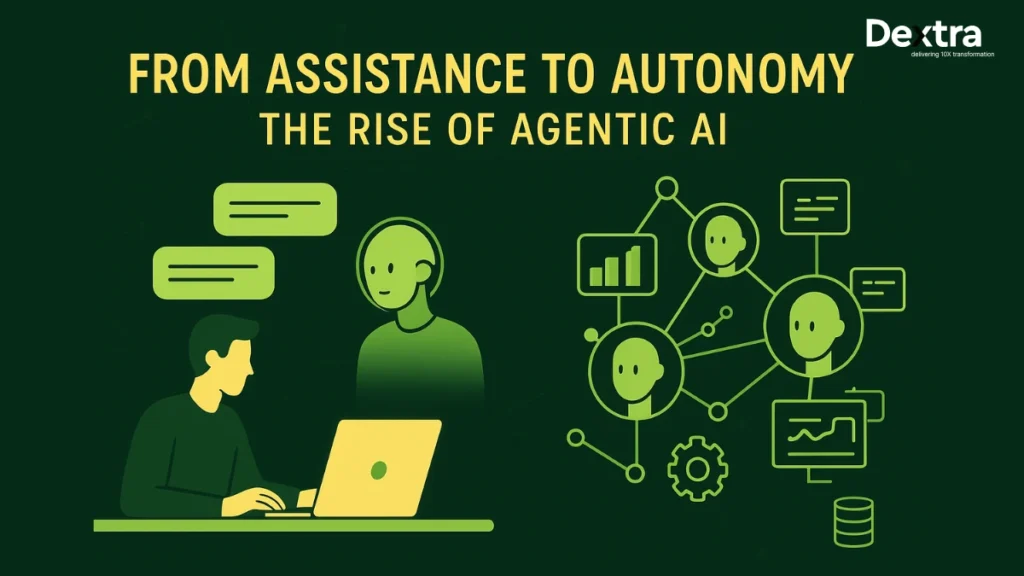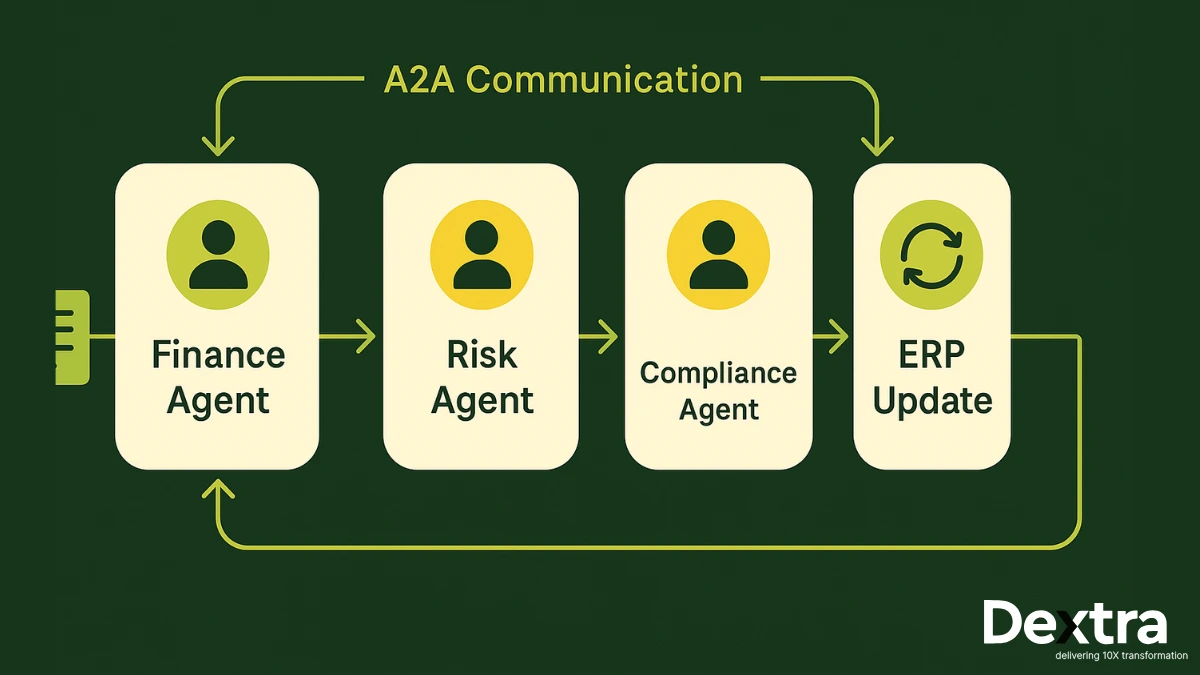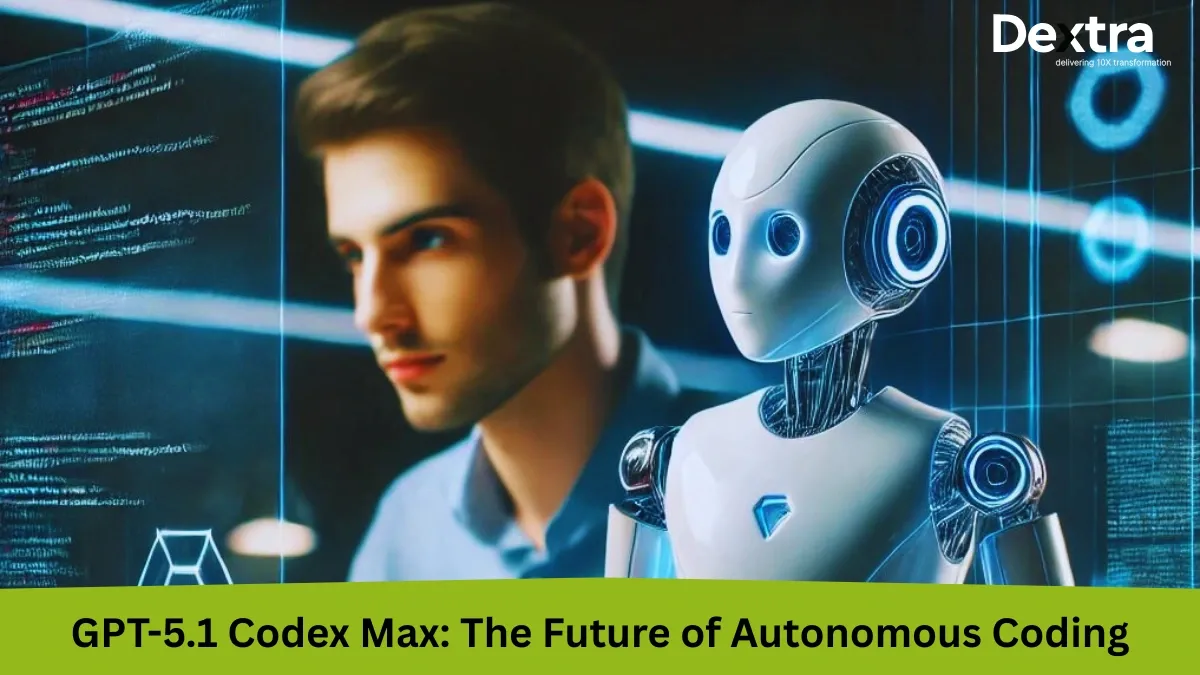The way enterprises use AI is changing fast. It’s no longer just about automating regular tasks; it’s about creating systems that can think, decide, and act independently. In other words, the enterprise AI evolution isn’t just about automation; it’s about decision autonomy.
A recent report by Cloudera (2025) found that 96% of enterprises plan to expand their use of AI agents in the next 12 months. Yet, only 1% of companies say their AI systems are mature enough to make independent decisions (McKinsey, 2025). This gap between ambition and maturity shows that enterprises are still operating in assisted workflows where AI supports humans but doesn’t yet operate on its own.
To understand this shift, we first need to look at two key types of AI systems:
- AI Copilots represent assistive intelligence; they help humans complete tasks faster and with better accuracy.
- Agentic AI represents autonomous intelligence systems that can plan, reason, and execute workflows end-to-end without constant supervision.
Right now, most enterprises are still in the “copilot” phase. Their tools assist but can’t fully act. The next step is unlocking autonomous orchestration, where multiple AI agents collaborate, make decisions, and execute tasks safely under HITL governance and safety rails.
From Copilots to Agents: The Functional Divide
Most enterprises started their AI journey with copilots. They are used for tasks such as writing reports, summarizing documents, or even giving code suggestions. Simply put, copilots aid humans in making decisions.
But as businesses grow, copilots often reach their limits. They work well for single tasks but struggle with multi-step, connected workflows that require reasoning and real-time decision-making. That’s where Agentic AI comes in.
Agentic AI goes beyond assistance. It represents systems that can plan, reason, and execute workflows end-to-end. Instead of waiting for human input at every step, agentic systems act on goals, understanding context, managing tasks across tools, and learning from outcomes.
These systems leverage AI orchestration to integrate several agents and tools under specified guardrails. They also exist in HITL (Human-in-the-Loop) governance, so humans continue to guide and oversee high-impact decisions. Autonomous workflows are safe and scalable through this balance of autonomy and oversight.
Here’s a simple comparison:
| Capability | AI Copilot (Assistive Intelligence) | Agentic AI (Autonomous Intelligence) |
| Autonomy | Limited – acts only on user prompts | High – executes actions based on goals |
| Context Awareness | Task-level understanding | End-to-end workflow understanding |
| Orchestration Capability | Works in isolation | Coordinates multiple systems and tools |
| Human Role | Constant supervision | Oversight under HITL governance |
| Outcome | Task completion | Goal achievement and continuous learning |
Copilots assist within boundaries, while agentic systems operate with purpose.
The move from copilots to agents marks the real beginning of autonomous workflows, where enterprises gain the power to execute faster, scale smarter, and make better decisions with fewer manual touch points.
When Copilots Reach Their Limit?
AI copilots have transformed how teams work. They make routine tasks faster and easier, like drafting emails, summarizing reports, or assisting with code. But as enterprises grow, these tools start to show their limits.
The first bottleneck is linear task automation. Copilots work in a straight line; you give a command, they complete a single task, and they stop. Modern enterprises need cyclical reasoning loops, where systems can analyze results, learn from feedback, and make the next decision automatically. Copilots aren’t designed for that level of reasoning.
The second challenge is cognitive overload. As more teams adopt AI tools, managing dozens of copilots across departments becomes difficult. Every tool requires human supervision, review, and coordination. Instead of saving time, it often increases dependency on people to keep workflows moving.
The third limitation is cost and scalability. Running multiple copilots for different functions sales, HR, operations, and tech creates overlap and inefficiency. A single orchestrated agent framework, on the other hand, can connect all these tools under one decision-making system, reducing cost and complexity.
Let’s look at a few enterprise examples:
- Lead qualification: Copilots can help analyze leads, but they still need human input to rank, score, and route them. An autonomous agent could handle the entire process from scoring to follow-up using data from multiple systems.
- Claims processing: Copilots assist in reading and summarizing documents. Agentic AI can go further verifying claims, checking policies, and even approving low-risk cases autonomously.
- Code deployment: Developers use copilots to generate code but still manage testing, integration, and deployment manually. With AI orchestration, agentic systems can handle these steps safely under HITL governance, improving speed and reliability.
These limits don’t mean copilots failed; they’ve helped enterprises take the first step toward AI adoption. But the next phase needs more than assistance. It needs autonomous orchestration where agentic AI handles complexity, scales intelligently, and allows humans to focus on strategy, not supervision.
Understanding Autonomous Execution with Agentic AI
Agentic AI is AI software built to not only recommend actions but also autonomously perform tasks under guided rules and human supervision. It works under safety rails and HITL (Human-in-the-Loop) management so that automation is not a threat to safety, compliance, or organizational goals. Humans step in on key decisions, authenticate exceptions, or adjust agent behavior in real time.
How AI Agents Work: Architecture Layers
AI agents are often structured into four functional layers:
- Perception
- The agent collects data from various sources: text, sensors, APIs, databases.
- Example: A sales AI agent perceives incoming leads from email, CRM, and web forms.
- Reasoning
- The agent processes information, evaluates options, and plans actions.
- Uses LLMs, decision trees, or reinforcement learning for decision-making.
- Example: Determining which lead is most likely to convert.
- Orchestration
- Coordinates multiple AI components or agents, aligning them toward a goal.
- Handles dependencies, task prioritization, and sequential logic.
- Example: Routing the lead to the right sales rep and triggering follow-up emails automatically.
- Execution
- The agent acts on its decisions, interacting with systems, APIs, or even humans.
- Example: Updating the CRM, sending notifications, or escalating high-priority leads.
AI Agents in Production
Deploying AI agents in real-world enterprise workflows requires robust architecture, monitoring, and governance:
- Multi-agent systems can work together, each handling a specialized function, improving efficiency.
- Production deployment emphasizes stability, traceability, and compliance, ensuring that agents behave reliably under diverse scenarios.
- Enterprises benefit from reduced latency, as agents make real-time decisions faster than human-driven processes.
- Decision quality improves, since agents can analyze vast amounts of data systematically and without fatigue.
Key Benefits of Autonomous Agents
| Benefit | Example in Enterprise |
| Faster Decision-Making | AI agent qualifies leads instantly, reducing sales cycle time. |
| Improved Accuracy | Automated claims processing reduces human error. |
| Scalability | Agents handle thousands of tasks in parallel without additional staff. |
| Human Oversight | HITL ensures sensitive decisions receive expert review. |
Autonomous AI agents are transforming enterprises by combining human judgment with machine efficiency, allowing organizations to execute complex workflows faster, more accurately, and with controlled risk.
Transition Framework: When and How to Move to Autonomous AI
Enterprises don’t jump straight to fully autonomous systems; success depends on signals of readiness and a structured roadmap for agentic AI for enterprises.
Signals an Enterprise is Ready for Autonomy
- Mature Copilots Usage
- Teams are effectively using AI copilots in daily workflows.
- Example: Document drafting, lead scoring, or code suggestions are consistently supported by AI tools.
- Stable Data Pipelines
- Reliable, clean, and connected data ensures AI agents in production can reason and act accurately.
- Reliable, clean, and connected data ensures AI agents in production can reason and act accurately.
- Clear Governance Models & Safety Rails
- Defined HITL governance processes and automated safety rails are in place.
- Example: Sensitive decisions require human review before execution; audit trails are enforced.
These signals indicate that the enterprise ecosystem is mature enough to support autonomous AI agent production safely and efficiently.
Dextralabs’ Recommended Roadmap to Autonomy

- AI Maturity Audit
- Assess current AI usage, data quality, and team readiness.
- Identify gaps in tooling, governance, and workflow integration.
- Pilot Orchestration
- Deploy small-scale multi-agent orchestration in controlled workflows.
- Test agent reasoning, execution, and integration with safety rails and HITL processes.
- Closed-Loop Deployment
- Implement agents with feedback loops to monitor performance, correct errors, and refine reasoning.
- Implement agents with feedback loops to monitor performance, correct errors, and refine reasoning.
- Production Scale
- Scale autonomous agents across enterprise workflows while maintaining safety rails and governance.
- Continuously optimize AI agents in production for faster, high-quality decision-making.
Risk Management and Governance in Agentic AI
Deploying AI agents in production requires robust risk management to ensure safety, compliance, and operational integrity. Enterprises must balance autonomy with control, emphasizing transparency, human oversight, and regulatory adherence.
Key Pillars of Governance
- Regulatory Compliance
- AI systems operate under relevant laws and industry standards.
- Agents automatically log decisions and maintain audit trails to meet compliance requirements.
- Example: GDPR-compliant data handling or financial services regulatory checks.
- Transparency
- Decision-making processes of AI agents are explainable to humans.
- Stakeholders can understand why an agent took a specific action, supporting accountability and trust.
- Human Override (HITL Governance)
- Humans remain in the loop for critical or high-risk decisions.
- HITL ensures that even autonomous agents cannot bypass safety protocols.
- Example: A claims-processing agent flags unusual claims for human review before approval.
Dextralabs’ Approach
Dextralabs integrates HITL governance and safety guardrails into enterprise-grade agentic AI for enterprises by:
- Embedding automated safety checks within multi-agent orchestration.
- Creating feedback loops where humans can correct, refine, or override agent actions.
- Monitoring performance continuously to ensure agents remain compliant, safe, and reliable.
- Ensuring that all agents operating in production adhere to transparent decision logs for accountability.
Outcome
By combining autonomous execution with robust governance, Dextralabs enables enterprises to deploy AI agents in production that are:
- Fast and scalable
- Accurate and reliable
- Fully aligned with regulatory and internal safety requirements
Real-World Use Cases: From Copilots to Autonomous Agents
Enterprises are increasingly moving from AI copilot tools that assist humans to fully autonomous AI agents capable of executing complex workflows with minimal human intervention. Here are some anonymized examples:
1. Financial Operations Automation
- Copilot Phase: Accounting teams utilized AI copilots to prepare reports, classify transactions, and mark anomalies.
- Autonomous Agent Phase: Multi-agent systems currently reconcile accounts automatically, identify odd patterns, and initiate compliance scans in real-time.
- Impact: 60% less manual effort, quicker month-end closures, and fewer errors, with humans still in the loop for high-risk transactions.
2. Supply Chain Orchestration
- Copilot Stage: Procurement teams used AI copilots to drive demand forecasting and vendor suggestions.
- Autonomous Agent Stage: Autonomous AI agents continuously monitor inventory levels, streamline procurement schedules, and orchestrate multi-supplier shipments.
- Impact: Better fulfillment efficiency, lower stockouts, and shorter supply chain lead times, with humans monitoring exceptions.
3. Customer Service with Autonomous Reasoning Agents
- Copilot Stage: Support agents employed AI to make recommendations for responses and prewrite responses for typical questions.
- Autonomous Agent Stage: Agents currently categorize customer intent, handle standard questions independently, and only forward difficult ones when human judgment is necessary.
- Impact: Accelerated times to resolve, enhanced customer satisfaction, and lessened agent workload, all while retaining governance and safety rails.
Key ROI Differentiators for Founders
Transitioning from copilots to agentic AI for enterprises isn’t just a technological upgrade it’s a business transformation that directly impacts ROI and scalability.
1. Reduced Supervision Hours
- Autonomous agents reduce the requirement for continuous human observation.
- Teams can redirect attention from operational control towards strategic decision-making.
- Example: Customer support and finance workflows now operate independently under HITL management, cutting down human oversight by as much as 70%.
2. Lower Operational Cost per Workflow
- By using AI agents in production, businesses cut the costs of repetitive labor without compromising output quality.
- Multi-agent orchestration guarantees best-resource utilization, allowing for more output for each dollar expended.
3. Enhanced Scalability through Continuous Learning Loops
- Each autonomous cycle improves the next; agents learn from feedback, refine reasoning, and self-optimize.
- This creates compounding efficiency over time, helping enterprises scale without proportionate cost increases.
Discover where your enterprise sits in the Copilot–Agent Continuum.
Dextralabs helps organizations assess readiness, orchestrate pilots, and deploy autonomous AI agents safely and at scale.
Dextralabs’ Role in Enterprise Autonomy
Dextralabs partners with global enterprises to help them transition from copilots to fully agentic AI systems combining strategy, orchestration, and implementation expertise.
With our AI consulting operations across the USA, UK, UAE, and India, Dextralabs enables organizations to:
- Orchestrate AI agents across workflows for higher operational efficiency.
- Modernize legacy applications with AI, embedding autonomous reasoning and continuous learning loops.
- Implement enterprise-ready agentic systems equipped with safety rails and HITL governance for secure, compliant deployment.
Through structured audits, pilot deployments, and production-scale rollouts, Dextralabs helps enterprises unlock the full ROI potential of AI agents in production.
Schedule a consultation to check your enterprise AI maturity.
Discover how Dextralabs can accelerate your journey toward scalable, compliant, and autonomous enterprise systems.
Conclusion
The growth of agentic AI marks a defining shift in enterprise intelligence from assistance to autonomy. It’s not about replacing human collaboration; it’s about elevating it.
What began as copilots supporting task execution is now evolving into orchestrated systems of autonomous agents capable of reasoning, learning, and executing with precision, all within structured safety rails and HITL governance.
Enterprises embracing this shift aren’t just automating workflows; they’re building adaptive ecosystems that think, learn, and act in sync with business goals.
As the Copilot–Agent spectrum matures, those who invest early in agentic autonomy will reap the benefits of a commanding competitive advantage, expedited execution, enlightened decision loops, and scalable innovation at all levels.
It is not about human vs machine, It’s about humans designing systems intelligent enough to work alongside them and bold enough to act for them.
FAQs on Agentic AI vs Copilots:
Q. When should an enterprise move from AI copilots to agentic AI?
Enterprises should transition when they have mature AI adoption, reliable data pipelines, and HITL (Human-in-the-Loop) governance in place. These conditions signal readiness for safe autonomous execution.
Q. How do agentic AI systems ensure safety and compliance?
Agentic AI operates under governance models that include safety rails, transparent decision logs, and HITL oversight. This ensures adherence to compliance standards and prevents uncontrolled automation.
Q. Can agentic AI replace humans in enterprise workflows?
No, agentic AI complements human intelligence by handling repetitive decision loops while humans guide strategy, validate key actions, and ensure organizational alignment through oversight.
Q. How do autonomous AI agents work in enterprise production?
Autonomous agents perceive data, reason through decisions, orchestrate actions across tools, and execute workflows securely. Multi-agent systems collaborate to achieve business goals efficiently under monitored environments.
Q. What ROI benefits can enterprises expect from adopting agentic AI?
Agentic AI reduces manual supervision, lowers operational costs, and scales intelligently through continuous learning loops. Enterprises typically see faster execution, higher accuracy, and improved resource utilization.
Q. How does Dextralabs help enterprises transition to agentic AI?
Dextralabs provides an end-to-end roadmap. From maturity audits to pilot orchestration and production-scale deployment, we ensuring safe, compliant, and scalable adoption of autonomous AI systems across global enterprises.
Q. What is the difference between AI copilots and agentic AI?
The main difference between AI copilots and agentic AI is that AI copilots provide assistance for specific tasks like writing or coding, while agentic AI can plan, reason, and execute end-to-end workflows autonomously. Copilots assist humans; agentic AI acts on goals with minimal supervision.








